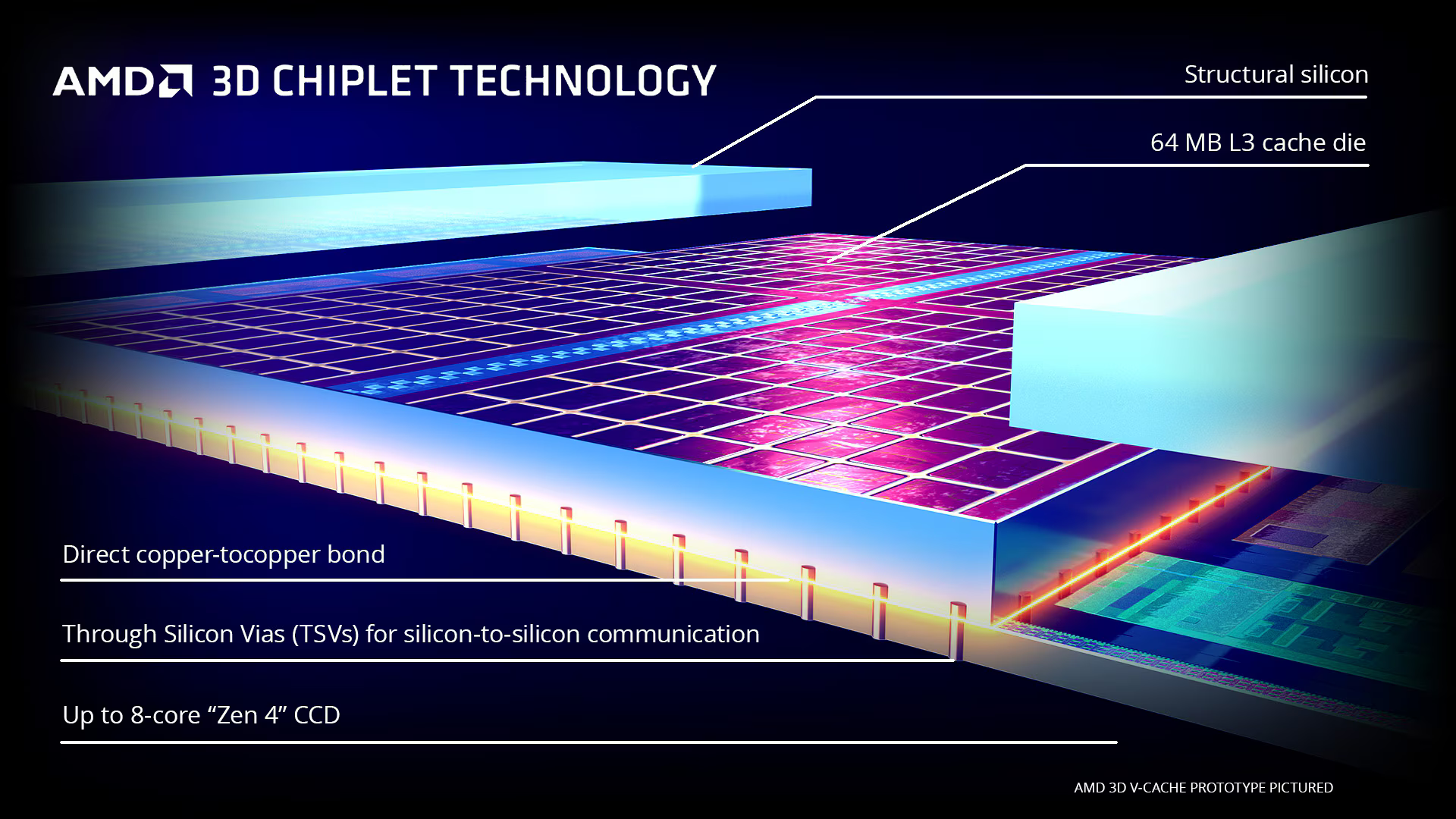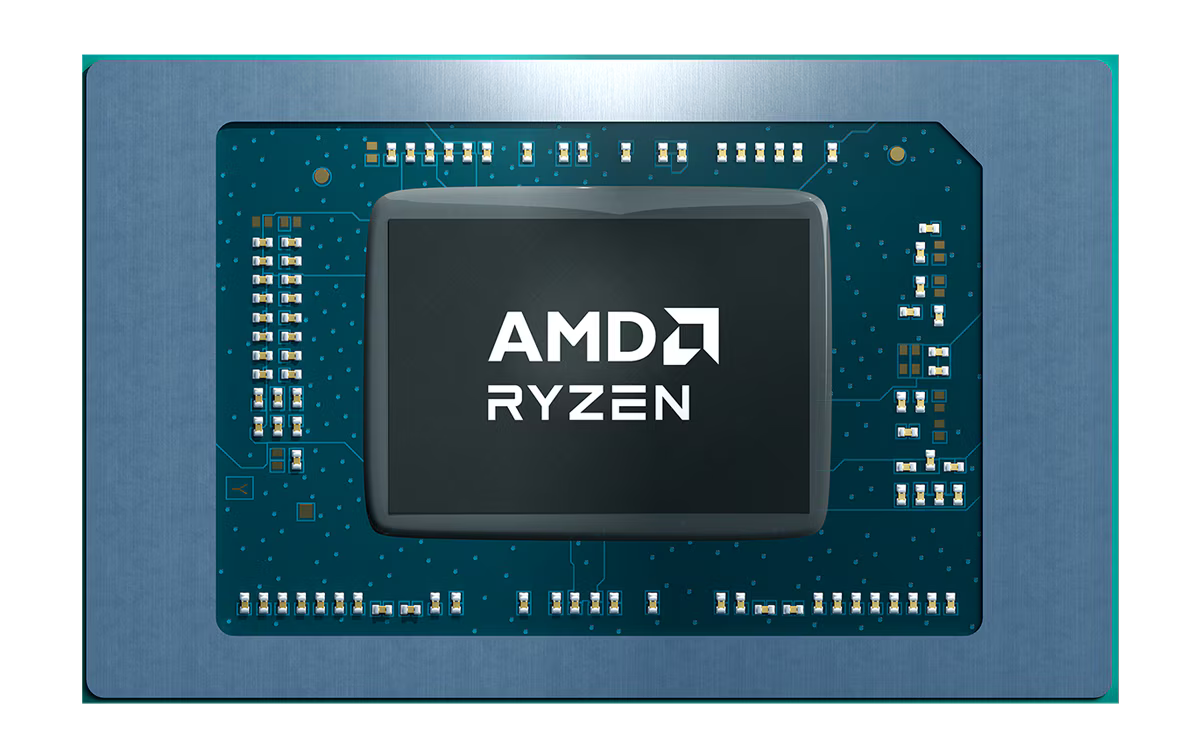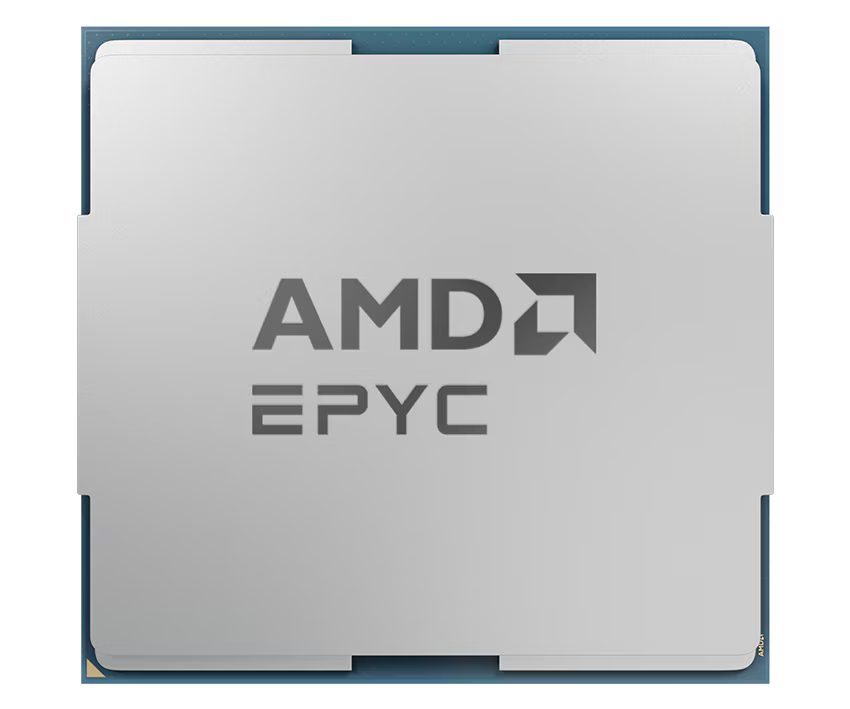AMD 3D V-Cache™ Technology
AMD 3D V-Cache™ Technology
Innovative 3D stacking technology to enable the world’s fastest gaming processors¹ – the AMD Ryzen™ 7000X3D series - and the world’s highest-performing server processors for technical computing² - the AMD EPYC 9684X processor.
AMD 3D V-Cache™ Technology Drives Density and Energy Efficiency Leadership
>200X
Interconnect Density
Compared to On-Package 2D Chiplet
>15X
Interconnect Density
Compared to Micro Bump 3D
Based on AMD Internal Data
>3X
Interconnect Energy Efficiency
Compared to Micro Bump 3D


Dig Deeper into AMD 3D V-Cache Technology
AMD Ryzen processors with AMD 3D V-Cache™ Technology
AMD continues to be the leader in advanced packaging technology with AMD 3D V-Cache™ technology. AMD is enabling a 3D vertical cache to create the world’s fastest gaming desktop processor when it was launched3 – the AMD Ryzen 7 5800X3D – and today, the world’s new fastest gaming processor lineup with AMD Ryzen 7000X3D processors1.


AMD EPYC 9004 Series Processors with AMD 3D V-Cache™ Technology
AMD Ryzen processors with AMD 3D V-Cache™ Technology
With the addition of AMD 3D V-Cache™ technology, EPYC processors reach new heights to become the world’s highest performing x86 server processors for technical computing2—designed to accelerate product development cycles and boost productivity. These are the first server processors to leverage true 3D die stacking, using a copper-to-copper “bumpless” design that enables 200X the interconnect density compared to current 2D technologies and over 15X the interconnect density compared to other 3D technologies using solder bumps.4
- Deliver breakthrough per-core performance with 3X the L3 cache/1152 MBs per socket
- Help lower TCO while accelerating product development
- Support sustainability through exceptional energy efficiency
- Provide the confidence of modern security
- Socket compatible with existing AMD EPYC 9004 platforms


Products Featuring AMD 3D V-Cache™ Technology
- RPL-39: Testing as of 15 December, 2022, by AMD Performance Labs using the following hardware: AMD Ryzen 7 7800X3D and Ryzen 9 7950X3D system: AM5 Reference Motherboard, 32GB DDR5-6000, and Artic Liquid Freezer II cooler. Intel Core i9-13900K system: ASUS Strix Z790-E Gaming Motherboard, 32GB DDR5-6000, and Artic Liquid Freezer II cooler. ALL SYSTEMS configured with an open air test bench, Windows 11, AMD Smart Access Memory technology ON, Virtualization-Based Security (VBS) OFF. Gaming performance calculated with Assassin's Creed: Valhalla, Borderlands 3, CS:GO, Cyberpunk 2077, Deus Ex: Mankind Divided, DOTA 2, F1 2021, Far Cry 6, Final Fantasy XIV, Ghost Recon Breakpoint, Grand Theft Auto V, Hitman 3 Dubai CPU, Hitman 3 Dubai GPU, Metro Exodus, Middle Earth: Shadow of War, Shadow of the Tomb Raider, Strange Brigade, Total War: Three Kingdoms Battle, Warhammer: Dawn of War III, Watchdogs: Legion, Wolfenstein Youngblood (LabX), World of Tanks Encore, Rifbreaker CPU, Red Dead Redemption 2, Forza Horizon 5, Guardians Of The Galaxy, Tiny Tina's Wonderland, Dirt 5, Civilization VI, Horizon Zero Dawn, Ashes of the Singularity (GPU), Total War Warhammer III (Battle), F1 2022, all at 1080p high settings. System manufacturers may vary configurations, yielding different results. RPL-39
- SP5-165 The EPYC 9684X CPU is the world’s highest performance x86 server CPU for technical computing, comparison based on SPEC.org publications as of 6/13/2023 measuring the score, rating or jobs/day for each of SPECrate®2017_fp_base (SP5-009E), Altair AcuSolve (https://www.amd.com/en/processors/server-tech-docs/amd-epyc-9004x-pb-altair-acusolve.pdf), Ansys Fluent (https://www.amd.com/en/processors/server-tech-docs/amd-epyc-9004x-pb-ansys-fluent.pdf), OpenFOAM (https://www.amd.com/en/processors/server-tech-docs/amd-epyc-9004x-pb-openfoam.pdf), Ansys LS-Dyna (https://www.amd.com/en/processors/server-tech-docs/amd-epyc-9004x-pb-ansys-ls-dyna.pdf), and Altair Radioss (https://www.amd.com/en/processors/server-tech-docs/amd-epyc-9004x-pb-altair-radioss.pdf) application test case simulations average speedup on 2P servers running 96-core EPYC 9684X vs top 2P performance general-purpose 56-core Intel Xeon Platinum 8480+ or top-of-stack 60-core Xeon 8490H based server for technical computing performance leadership. “Technical Computing” or “Technical Computing Workloads” as defined by AMD can include: electronic design automation, computational fluid dynamics, finite element analysis, seismic tomography, weather forecasting, quantum mechanics, climate research, molecular modeling, or similar workloads. Results may vary based on factors including silicon version, hardware and software configuration and driver versions. SPEC®, SPECrate® and SPEC CPU® are registered trademarks of the Standard Performance Evaluation Corporation. See www.spec.org for more information.
- Based on testing by AMD as of 12/14/2021. Performance evaluated with Watch Dogs Legion, Far Cry 6, Gears 5, Final Fantasy XIV, Shadow of the Tomb Raider and CS:GO. All games test at 1920x1080p resolution with the HIGH in-game quality preset (or equivalent). System configuration: Ryzen 7 5800X3D and AMD Reference Motherboard with 2x8GB DDR4-3600. Core i9-12900K and ROG Maximus Z690 Hero motherboard with BIOS 0702 and 2x16GB DDR5-5200. Both systems configured with GeForce RTX 3080 on driver 472.12, Samsung 980 Pro 1TB, NZXT Kraken X62, Windows 11 28000.282. R5K-107
- Based on calculated areal density and based on bump pitch between AMD hybrid bond AMD 3D V-Cache stacked technology compared to AMD 2D chiplet technology and Intel 3D stacked micro-bump technology. EPYC-026
